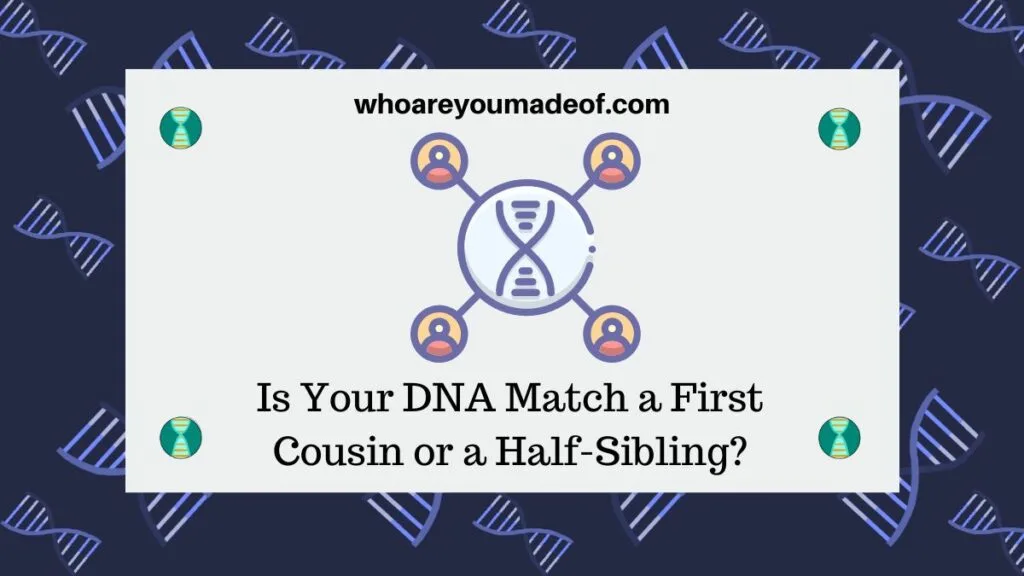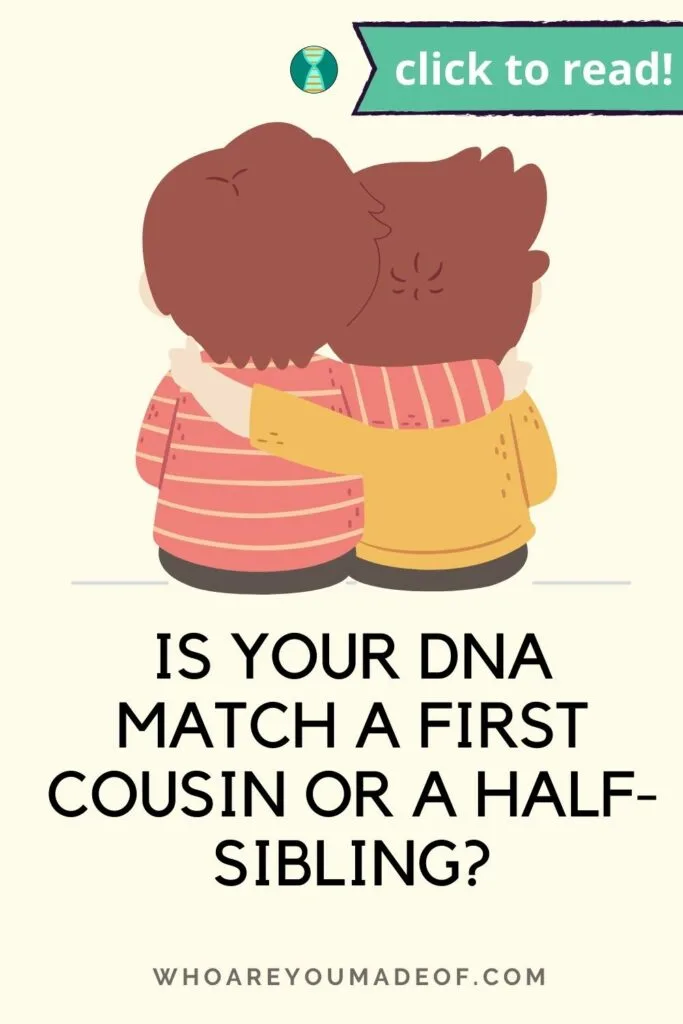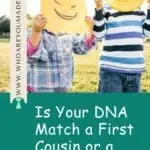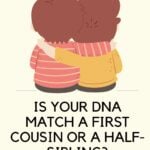Do you have a DNA match that shows up in the first cousin category? Are you wondering how to figure out if this match is a first cousin or a half-sibling?
In this post, I’ll provide the information that you need to figure out exactly how your DNA match is related to you.

When it comes to close DNA matches, it’s very understandable that you want as much information possible to figure out how you fit into each other’s family tree.
Unfortunately, while we can count on autosomal DNA testing to point out who our close relatives are, the testing companies usually can’t tell us exactly how we are related to each other. We are typically provided with an estimate of our relationship, and it is up to us to figure out the most important details.
Is the estimated relationship on my DNA match list correct?
Before we get started, it is important to mention that the estimated relationship, and even the category in which your DNA match is placed, is usually not indicative of your actual genealogical relationship.
DNA testing companies use the amount of DNA that is shared between you and your match in order to be able to predict your possible relationship. Since there are lots of different types of genealogical relationships, DNA testing companies usually divide matches into very general groups (i.e. Close Family, Immediate Family, First Cousins, Second Cousins).
In reality, there are lots of nuances in genealogical relationships. For example, a person who falls into the second cousin category of DNA matches can be a first cousin once or twice-removed.
Relevant to discussion in this post, a person who is in the “first cousin” category can actually be a half-sibling.
We can use the same information that DNA testing companies use, along with common sense, family tree information, geographic locations, family stories, and other data to make a more realistic determination about how our DNA matches are really related to us.
DNA testing companies don’t know all of this information about our families, and so we are in the best position to make these determinations.
How many centimorgans do you share with your first cousin/half-sibling match?
The first bit of information that you should look for when you are trying to figure out if your DNA match is a first cousin or a half-sibling is the number of total shared centimorgans. Centimorgans are often abbreviated as “cMs” or “cM”.
All of the testing companies generally display this information in a prominent place on the DNA match list.
- First cousins (not half-first cousins) who share both grandparents on one side of their family will share between 575-1330 cMs. Half-first cousins, whose parents are half-siblings, will share about half that amount (215-650 cMs).
- Half-siblings, who obviously share only one parent as opposed to both, typically share between 1300-2300 cMs. Full siblings will share 2300-2900 cMs, to show the contrast.
As you might notice, there is a small overlap in the ranges of shared DNA between these relationship types, meaning that – according to the ranges – if you share more than 1300 and less than 1330 with your match, you won’t be able to rule out either relationship.
In reality, the “overlap” of the ranges is a little bigger than just 30 centimorgans. The result of this is that if you share more than about 1250 cMs and less than about 1350 cMs with your match, you could be half-siblings or first cousins.
Any amount of shared centimorgans significantly under the range means that you are not half-siblings, and any amount significantly over the range means that you are not first cousins.
There is one exception to this rule: Double first cousins (people who share both sets of grandparents because their parents married siblings) will share a total amount of centimorgans that fall into the half-sibling range.
Most people are aware when they have a double-first cousin situation in their family. It’s not as uncommon as you might think!
Also related to this topic is the fact that descendants of double-first cousins will also share more DNA with each other than people generally would at their relationship distance.
There are other relationship types that share the same amount of DNA as half-siblings and first cousins
If you didn’t see overlap in your shared DNA range with the other relationship type, you might be excited, thinking that you have discovered how your match is related to you.
There is something that you need to know, however. People who share DNA that fall within either the first cousin or half-sibling range should know that there are other relatives that also share DNA within those same ranges.
This means that before you decide whether or not your match is a half-sibling or a first cousin, you need to make sure that your match doesn’t have a different relationship to you.
A few other relationship possibilities that fall into the same 575-1330 cM range for first cousins are included below. Depending on your age, and the age of your match, you might be able to easily eliminate some of these possibilities:
- Half-aunt, half-uncle (shares one parent with your parent, in other words, you parents are half-siblings)
- Half-niece, half-nephew (a child of your half-sibling)
- Great-grandparent
- Great-grandchild
- Great-aunt/uncle
- Great-nephew/niece
Just like with the first cousin relationship range, there are other relationship types that fall into the same range as half-siblings. As you know, half-siblings typically share 1300-2300 cMs, and the following types of relationships also fall in the same range:
- Grandparent
- Grandchild
- Aunt or uncle
- Niece or nephew
What if the total shared centimorgans falls in the overlap? First cousin or half-sibling?
If you’ve gotten to this point in this post, I’m assuming that you’ve eliminated any other relationship possibility, like the ones I mentioned above, and you are trying to decide whether your DNA match is a first cousin or half-sibling.
If your DNA match falls within a range of about 1250-1350, it will be very difficult to be able to determine for sure how you are related to your match.
Fortunately, there are a few things that you can do to try to gather more information to help you figure out if your DNA match is a first cousin or half-sibling.
Testing family members can provide more data points
Have you tested any other family members? Shared DNA between your first cousin/half-sibling match and other known family members with whom you have a verified DNA relationship can help you figure out which type of relationship is most likely.
For example, if you have an aunt or uncle on the same side of the family as your possible half-sibling or first cousin, their DNA results might reveal more about where your match fits into your family tree.
Uploading to Gedmatch can help you and your first cousin/half-sibling find more matches
If you are your DNA match are communicating with each other, you could both upload your DNA to Gedmatch. You might have additional relatives on the site that could provide more DNA information that can help you.
Two sisters with the same father will share a full X chromosome
If you are female and your DNA match is female, and you believe that you share a father, then you can compare your X chromosomes. Two females with the same father will share a full X chromosome.
There are a few ways to do this, but there is a free tool on a site called Gedmatch that allows X DNA comparison. It’s important to note that two siblings with the same mother will also share X DNA, but the X DNA is usually passed down from the mother in smaller segments (because the mother has two X chromosomes that recombine to pass down to her offspring).
Old-fashioned genealogy can help you figure out if your match is a first cousin or a half-sibling
Leaving the DNA aside for a moment, there are significant bits of information that can be learned from more traditional genealogical methods. For example, if you are trying to figure out if a person is a half-sibling or a first cousin, this means that you have several potential parents in mind for your match.
The potential parent ranges from your parent (in the case that your match is a half-sibling) to your aunts and uncles (on the side of the family that you believe that your match is on).
Remember that if your DNA match’s parent is an aunt or uncle, it must be a FULL aunt or uncle – meaning that they must share both of your parent’s parents. You can eliminate any of your parent’s half-siblings as potential parents to your match, since they would share about half as much DNA with you, as I have mentioned before.
There are lots of questions that you can ask (yourself, or to your match) that can help you figure out which relationship scenario is most likely.
Do you and your DNA match’s trees both make sense?
Do you and your match have family trees? If you both have family trees, and the relationships in your trees seem to make sense, you can probably take the trees at their face value.
A vast majority of people are aware of who their parents are, and so if they have parents listed in their trees, and this helps you resolve your first-cousin/half-sibling question, I would accept the answer as valid.
First cousin vs. half-sibling? Examine the facts of the case.
How old is your DNA match? Which geographic locations were the potential parents of your matches living in when your DNA match was born?
Often times, this can help us eliminate possibilities or immediately decide on a potential parent for our match. For example, if you have two uncles and one uncle was stationed in Germany when your DNA match was born, and your other uncle lived in the same state where your match was born, and your parent lived in a completely different US state, you have a big clue.
Contact your DNA match to get their help in deciding whether you are half-siblings or first cousins
If you haven’t contacted your DNA match, consider doing so. You might strike up a good friendship and/or family relationship, and you might be able to work together to work out your “real” genealogical relationship.
Conclusion
One thing is for sure: If your DNA match shares about 1300 centimorgans with you, they are a pretty close relative. Whether or not you are able to figure out the exact relationship, at the end of the day, is no matter.
Enjoy your newly discovered family member!
If you have any questions about something that you read in this post, or would like to share your own experience trying to determine whether your match is a first cousin or a half-sibling, I would love to hear from you in the discussion below.
Thanks for stopping by today!





Sue
Monday 4th of March 2024
Hi. I have a dna match of 17% with 1156cm. Could this be a half sibling?
Thomas Turner
Tuesday 12th of December 2023
I recently discovered a relationship with 881cM. I believe this to be my mothers brothers child. Should I request a DNA test from my deceased uncles daughter or son? Which one will give the best results when matched through Gedmatch?
Patricia Croteau
Sunday 29th of October 2023
I have a first cousin on my father’s side She is coming up as a half-sibling. 1747 cM shared
Dianne
Sunday 17th of September 2023
Hi, my husband was adopted at birth. He knows his mother and has found a half brother. They share 1807 cM and 26% shared DNA. My husband doesn’t know his father. He recently found a match to another male, two years older, through his other parent. They share 1331 cM and 19% shared DNA. We have made contact. This man doesn’t know who his father was either and as both mothers have passed, neither of them have any further information. They share higher cM and shared DNA that I do with my known cousins, but not quite as much as my husband shared with the half brother who has the same mother. Any suggestions? Could they be half brothers? From my limited understanding, their shared numbers seem to be on the border. Any help would be appreciated. Thanks, Dianne 😊
Anne Conroy
Thursday 7th of September 2023
I have dna match with site proposing 1st cousin match. Cms shared are 1186 and 15.94% dna. I’ve messaged her and she’s told me she was adopted at birth. She has been given her biological parents’s names. These names are not my father or uncles. I don’t recognise either name. Her shared matches with me suggest my father’s side of family sharing same grandparents. Could this be a half sibling/half niece/ or a definite 1st cousin. I look forward to your opinion with 1186 centimorgans and 15.94 DNA. Thank you